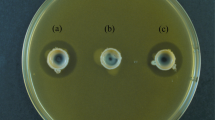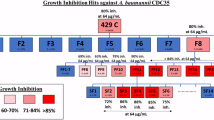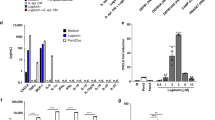Abstract
Decrease of ceramide in the skin is one of the aggravating factors of atopic dermatitis. The skin is often infected by ceramidase-producing bacteria, such as Pseudomonas aeruginosa. The bacterial ceramidase then degrades ceramide in the skin. To develop anti-atopic dermatitis drugs, we searched for ceramidase inhibitors, which led to the discovery of ceramidastin, a novel inhibitor of bacterial ceramidase, from the culture broth of Penicillium sp. Mer-f17067. Ceramidastin inhibited the bacterial ceramidase with an IC50 value of 6.25 μg ml−1. Here we describe the isolation, physicochemical properties, structure determination and biological activity of ceramidastin.
Similar content being viewed by others
Introduction
In the skin, ceramide forms a multilamelle structure in the stratum corneum and functions as a permeability barrier as well as a water retainer.1 However, the content of ceramide is found to be decreased in lesions of atopic skin.2 The decrease of ceramide induces dryness in the skin of patients with atopic dermatitis and compromises the permeability barrier, permitting the invasion of allergens or irritants.3 Interestingly, such atopic skin is frequently colonized by ceramidase-producing bacteria.4 Ceramidase is an enzyme that catalyzes the hydrolysis of the N-acyl linkage of ceramide to produce a free fatty acid and a sphingosine base. Ito and colleagues5 have isolated a ceramidase-producing bacterium, Pseudomonas aeruginosa AN17, from the skin of patients with atopic dermatitis and cloned the gene encoding its ceramidase.6 The hypothesis driving this study is that the ceramidase from colonizing bacteria contribute to the decrease of ceramide in atopic skin lesions, and that inhibiting bacterial ceramidase will prevent the decrease of ceramide in atopic skin and improve the disease. In the course of our screening for ceramidase inhibitors, we discovered ceramidastin, a novel inhibitor of bacterial ceramidase, from the culture broth of Penicillium sp. Mer-f17067. Here we describe the isolation, physicochemical properties, structure determination and biological activity of ceramidastin.
Materials and methods
Microorganism
Fungal strain Penicillium sp. Mer-f17067 was isolated from a soil sample collected from Iriomote Island, Okinawa prefecture, Japan. The fungal strain was cultured and kept on potato dextrose agar (Difco, Detroit, MI, USA). This strain has been deposited as NITE P-580 at the NITE Patent Microorganisms Depositary, Japan.
Taxonomic studies
The following media were used to identify the producing fungus: potato dextrose agar, 2% malt agar, oatmeal agar and Miura's medium (LcA). The formed colonies were observed after 1-week incubation at 25 °C. The colors used in this study were taken from Kornerup and Wanscher.7
Fermentation
Fungal strain Penicillium sp. Mer-f17067 grown on an agar slant was inoculated into 100 ml of a seed medium containing 2% potato starch, 1% glucose, 2% Soypro (J-Oil Mills Inc., Tokyo, Japan), 0.1% KH2PO4, 0.05% MgSO4·7H2O and three glass beads, and cultured at 25 °C for 3 days on a rotary shaker at 220 r.p.m. In all, 1 ml of the seed culture was inoculated into a 500-ml flask containing 100 ml of a culture medium consisting of 5% maltose hydrate, 1.5% Pharmamedia (Traders Protein, Memphis, TN, USA), 1% malt extract, 0.5% ammonium sulfate, 1% mineral solution (solution of 2% CoCl2·6H2O, 2% CaCl2 and 2% MgCl2; adjusted at pH 7 before sterilization) and cultured at 25 °C for 4 days on a rotary shaker at 220 r.p.m.
Analytical measurement
Melting points were obtained on a Yanagimoto micro melting point apparatus (Yanagimoto, Kyoto, Japan). Optical rotations were measured on a JASCO P-1030 polarimeter (JASCO, Tokyo, Japan). UV spectra were recorded on a Hitachi 228 A spectrometer (Hitachi, Tokyo, Japan). 1H and 13C NMR spectra were measured on a JEOL JNM A400 spectrometer (JEOL, Tokyo, Japan) using tetramethylsilane (TMS) as an internal standard. HRESI-MS spectra were measured with a JEOL JMS-T100LC spectrometer (JEOL).
Ceramidase activity
Ceramidase activity was assessed according to the method used by Okino et al.,5 with minor modifications. P. aeruginosa no. 12 was cultured in 3% Trypto-Soya Broth (Nissui Seiyaku, Tokyo, Japan) at 37 °C for 3 h on a rotary shaker at 100 r.p.m. In all, 15 μl of the seed culture was inoculated into 3 ml of a synthetic medium consisting of 0.05% NH4Cl, 0.05% K2HPO4, 0.5% NaCl (adjusted at pH 7.2 before sterilization) with 0.05% taurodeoxycholate and 0.05% sphingomyelin, and cultured at 30 °C for 24 h on a rotary shaker at 100 r.p.m. After filtration, the cultured supernatant was used as a source for bacterial ceramidase.
The activity of ceramidase was measured using 7-nitrobenz-2-oxa-1, 3-diazole-labeled N-dodecanoylsphingosine (C12-NBD-ceramide; Avanti Polar Lipids, Alabaster, AL, USA) as a substrate. Here, 10 μl of 10 μM C12-NBD-ceramide in 50 mM Tris-HCl (pH 8.5) was mixed with 10 μl of the bacterial ceramidase solution and incubated with ceramidastin at 37 °C for 2.5 h. The reaction was terminated by the addition of 100 μl of chloroform/methanol (2/1, v/v). The resulting solution was evaporated and resolved in 100 μl of chloroform/methanol (2/1, v/v). A sample of 20 μl was applied on a thin layer chromatography (TLC) plate, which was developed with chloroform:methanol:25% ammonia (90:20:0.5). The spot of C12-NBD-fatty acid released by the reaction of the enzyme on the TLC plate was quantified by an FLA5000 Image Reader (Fujifilm, Tokyo, Japan).
Atopic dermatitis model
We used NC/Nga female mice (6-week old; Charles River, Yokohama, Japan) as an atopic dermatitis model.8, 9 Hair was removed from the backside of the mice anesthetized with Nembutal. The hairless area was defatted by acetone:ether (1:1) and washed with distilled water. Then, 200 μl of 1/4 diluted ceramidase solution was applied on the defatted back. After 30 min, 200 μl of 1 mg ml−1 ceramidastin dissolved in distilled water was applied on the defatted back. The procedure of defatting and applications of ceramidase and ceramidastin were repeated twice a day for 5 days a week and continued until the end of the experiment. Forty days after the first treatment, the mouse was killed and the skin on the backside was excised. The skin was fixed in formalin solution and embedded in paraffin, cut into 4-μm sections and stained with toluidine blue.
Cytotoxicity
Cells were inoculated in 96-well plates at 5000 cells per well with ceramidastin and cultured for 2 days. The growth was determined using 3-(4,5-dimethylthiazol- 2-yl)-2,5-diphenyltetrazolium bromide (MTT; Sigma, St Louis, MO, USA).
Results
Taxonomy of the producing strain Mer-f17607
Colonies on potato dextrose agar plates were 32–34 mm in diameter, floccose to velvet and grayish blue (23C-4) to orange (5A6-7). Colonies on MA were 30–32 mm in diameter, velvet, and olive (1F-8) to pale orange (5A-3). Colonies on oatmeal agar plates were 35–37 mm in diameter, floccose to velvet, and dark green (25F-7) to light orange (5A4-5). Colonies on LcA plates were 25–28 mm in diameter, velvet, and olive (1F-8) to pale orange (5A-3). Soluble pigment was not found in the culture on any media. Vegetative hyphae were formed in or on agar plates, colorless and smooth in surface with septate hyphae. Conidiophores were orthotropous in vegetative hyphae, colorless and smooth in surface with metulae at the apex. Metulae were cylindrical and phialides were needle-like. Conidia were phialoconidia, one-celled, subrounded to rounded, smooth in surface and connected to each other like a chain from a phialide. Sexual reproductive organs were not found when the culture was observed for 2 weeks. These cultural and morphological characteristics suggest that the strain belonged to the genus Penicillium. On the basis of 28S rDNA-D1/D2 gene sequence data, the strain formed a distinct phyletic line from any known species in the genus Penicillium. Therefore, we classified it as a strain of Penicillium called Penicillium sp.
Isolation procedure for ceramidastin
The culture broth (5 l) was filtered and the filtrate was passed through a DIAION HP20 column (500 ml) equilibrated with H2O. After washing with H2O (2 l) and 20% acetone (2 l), the active material was eluted with 75% acetone (2 l). The eluate was concentrated in vacuo to remove acetone and diluted with H2O up to 2.2 l. After adjusting the pH to 8, the aqueous solution was extracted with BuOH. The aqueous layer was concentrated in vacuo to remove the residual BuOH and diluted with H2O up to 2.6 l. After adjusting the pH to 3, the aqueous solution was extracted with EtOAc (1.3 l × 2). The organic layer was concentrated in vacuo to give a brown material (1.5 g). A portion of the material was dissolved in a small volume of 20% acetonitrile containing 0.1% trifluoro acetic acid (TFA) and passed through an Inertsil ODS-3 column (20 × 250 mm) packed with the same solution. Active ingredients containing ceramidastin were eluted from the column using a linear gradient system (20–60% acetonitrile containing 0.1% TFA). The active ingredients containing ceramidastin were diluted with 10 volumes of H2O and applied on an HP20 column. After washing the column with H2O, elution was carried out using acetone to afford 245 mg of ceramidastin.
Physicochemical properties
The physicochemical properties of ceramidastin are summarized in Table 1. Ceramidastin was isolated as a white powder, which was soluble in water, MeOH, acetone and DMSO.
Structure determination
The molecular formula of ceramidastin was determined to be C26H34O11 on the basis of HRESI-MS (Table 1) and 13C NMR information. The 13C NMR spectrum (DMSO-d6) showed 26 discrete carbon signals, which were classified into one methyl, nine methylenes, eight methines, including two sp2 and six sp3 methines, four sp2 quaternary carbons and four carbonyl carbons by analysis of DEPT spectra. The connectivity of proton and carbon atoms was established by the 13C–1H heteronuclear multiple quantum coherence (HMQC) spectrum. Four of five hydroxyl signals were detected in the 1H NMR spectrum (Table 2). The connectivity of these hydroxyl moieties and relevant carbon atoms was established by the 1H–1H COSY and heteronuclear multiple bond connectivity (HMBC) experiments (Table 2 and Figure 2). The general features of 1H and 13C NMR spectra resembled those of rubratoxin A and B.10, 11 As shown by the bold lines in Figure 2, five partial structures, composed of I (-CH2-CH=CH-), II (-CH2-CH(CH2-)-CH(OH)-), III (-CH-CH(OH)-), IV (-CH-OH) and V (-CH2-CH3), were deduced from the 1H–1H COSY spectra. The arrow lines show that the partial structure from C-6 to C-26 in ceramidastin, which is completely preserved in rubratoxin B, was deduced from the HMBC spectra. Furthermore, 1H and 13C chemical shifts and coupling constants of ceramidastin were very similar to those of reported rubratoxin B, suggesting the same stereochemistry between the two compounds. The remaining part (HO-CH2-CH=CH-CH2-CH(OH)-), including the partial structure of ceramidastin, was elucidated to connect C-6 by the HMBC correlation from H-4 as shown in Figure 2. The coupling constant between 2-H and 3-H (J=15.3 Hz) indicated that the configuration at C-2/C-3 is E. Consequently, the total structure of ceramidastin was elucidated as shown in Figures 1 and 2.
Inhibition of Pseudomonas ceramidase
The effect of ceramidastin on bacterial ceramidase was assessed according to the method used by Okino et al.,5 with minor modifications. We used the supernatant of a culture of P. aeruginosa no. 12 as a source for bacterial ceramidase. As shown in Figure 3, ceramidastin inhibited Pseudomonas ceramidase with an IC50 value of 6.25 μg ml−1. On the contrary, ceramidastin did not inhibit human ceramidase even at 200 μg ml−1. Ceramidastin did not show anti-microbial and anti-fungal activities, including against P. aeruginosa, at 100 μg ml−1.
We next examined the effect of ceramidastin on atopic dermatitis model NC/Nga mice.8, 9 Mast cells are increased in the dermis with dermatitis.8 As shown in Figure 4, mast cells were increased in the dermis by Pseudomonas ceramidase application. However, ceramidastin treatment significantly inhibited the increase of mast cells in the dermis.
Effects of ceramidastin on NC/Nga mice skin. NC/Nga mice (6 mice per group) were treated with Pseudomonas ceramidase on the back skin with or without ceramidastin. Mast cells in the dermis were stained by toluidine blue and counted. (a) Mast cell counts in the dermis. The values were means±s.d. of 6 mice. (b) Representative photos of the dermis sections stained by toluidine blue.
Cytotoxicity in vitro and toxicity in mice
Ceramidastin did not show any cytotoxicity against human lung cancer cell lines, HCI-H23 and NCI-H522 cells, human colon cancer HT-29 cells, mouse melanoma B16BL6 cells, mouse colon cancer colon 26 cells, mouse lymphoma cell lines, EL-4 and L-1210 cells up to 100 μg ml−1.
Acute toxicity of ceramidastin in mice was examined using ICR female mice. When ceramidastin was administered intravenously, no fatality was observed up to 6.25 mg kg−1.
Discussion
It is reported that D-MAPP, a ceramide analog, inhibits human ceramidase.12 However, ceramidastin did not show inhibitory activity against human ceramidase. It is also reported that GCAS-4 and GCAS-7, other ceramide analogs, as well as D-MAPP inhibit the ceramidase activity of Pseudomonas culture with an IC50 value of 500 μM.13 We tested the effect of D-MAPP on Pseudomonas ceramidase in our assay system, and found that D-MAPP inhibited it with an IC50 value of 500 μg ml−1. Thus, ceramidastin is considered to be a more selective and stronger inhibitor of bacterial ceramidase.
Ceramidastin is structurally related to rubratoxins.10 We also examined the effect of rubratoxin A on Pseudomonas ceramidase, which showed that rubratoxin A did not inhibit it even at 100 μg ml−1. Thus, the structural difference of ceramidastin must be significant for its inhibitory action against bacterial ceramidase.
To evaluate the efficacy of ceramidastin on atopic dermatitis, we used NC/Nga mice. It is reported that tacrolimus hydrate improves spontaneous dermatitis in NC/Nga mice.8 Mast cells are increased in the dermis by allergic responses. Our result showed that ceramidastin inhibited the increase of mast cells in the dermis induced by Pseudomonas ceramidase. Ceramidastin showed neither anti-microbial nor anti-fungal activities, which is an advantage because there is a low possibility of inducing drug-resistant bacteria. Thus, it is suggested that ceramidastin would improve atopic dermatitis exacerbated by bacterial infection.
References
Elias, P. M. & Menon, G. K. Structural and lipid biochemical correlates of the epidermal permeability barrier. Adv. Lipid Res. 24, 1–26 (1991).
Imokawa, G. et al. Decreased level of ceramides in stratum corneum of atopic dermatitis: an etiologic factor in atopic dry skin? J. Invest. Dermatol. 96, 523–526 (1991).
Bos, J. D., Kapsenberg, M. L. & Smitt, J. H. Pathogenesis of atopic eczema. Lancet. 343, 1338–1341 (1994).
Ohnishi, Y., Okino, N., Ito, M. & Imayama, S. Ceramidase activity in bacterial skin flora as a possible cause of ceramide deficiency in atopic dermatitis. Clin. Diagn. Lab. Immunol. 6, 101–104 (1999).
Okino, N., Tani, M., Imayama, S. & Ito, M. Purification and characterization of a novel ceramidase from Pseudomonas aeruginosa. J. Biol. Chem. 273, 14368–14373 (1998).
Okino, N., Ichinose, S., Omori, A., Imayama, S., Nakamura, T. & Ito, M. Molecular cloning, sequencing, and expression of the gene encoding alkaline ceramidase from Pseudomonas aeruginosa: cloning of a ceramidase homologue from Mycobacterium tuberculosis. J. Biol. Chem. 274, 36616–36622 (1999).
Kornerup, A. & Wanscher, J. H. Methen Handbook of Colour, 3rd edn (Eyre Methen, London, UK, 1978).
Hiroi, J. et al. Effect of tacrolimus hydrate (FK506) ointment on spontaneous dermatitis in NC/Nga mice. Jpn. J. Pharmacol. 76, 175–183 (1998).
Aioi, A. et al. Impairment of skin barrier function in NC/Nga Tnd mice as a possible model for atopic dermatitis. Br. J. Dermatol. 144, 12–18 (2001).
Buchi, G., Snider, K. M., White, J. D., Gougoutas, J. Z. & Singh, S. Structure of rubratoxin A and B. J. Am. Chem. Soc. 92, 6638–6641 (1970).
Nieminen, S. & Tamm, C. 1H- and 13C-NMR spektroskopie der nonadride. Helv. Chim. Acta. 64, 2791–2801 (1981).
Bielawska, A. et al. (1S,2R)-D-erythro-2-(N-myristoylamino)-1-phenyl-1-propanol as an inhibitor of ceramidase. J. Biol. Chem. 271, 12646–12654 (1996).
Kita, K. et al. Activation of bacterial ceramidase by anionic glycerophospholipids: possible involvement in ceramidase hydrolysis on atopic skin by Pseudomonas ceramidase. Biochem. J. 362, 619–626 (2002).
Acknowledgements
We are grateful to Dr K Isshiki and Dr N Sakata (Mercian Corporation Bioresource Laboratories) for their valuable discussions. We also thank Dr R Sawa and Mrs Y Kubota (Microbial Chemistry Research Center) for HRESI-MS and NMR measurements.
Author information
Authors and Affiliations
Corresponding author
Rights and permissions
About this article
Cite this article
Inoue, H., Someno, T., Kato, T. et al. Ceramidastin, a novel bacterial ceramidase inhibitor, produced by Penicillium sp. Mer-f17067. J Antibiot 62, 63–67 (2009). https://doi.org/10.1038/ja.2008.10
Received:
Accepted:
Published:
Issue Date:
DOI: https://doi.org/10.1038/ja.2008.10
Keywords
This article is cited by
-
In silico analyses of maleidride biosynthetic gene clusters
Fungal Biology and Biotechnology (2022)
-
Regulation of metabolism and transport of sphingosine-1-phosphate in mammalian cells
Molecular and Cellular Biochemistry (2012)
-
Citric acid inhibits a bacterial ceramidase and alleviates atopic dermatitis in an animal model
The Journal of Antibiotics (2010)







